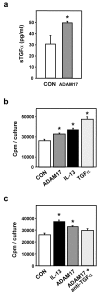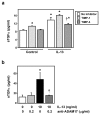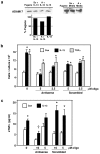IL-13-induced proliferation of airway epithelial cells: mediation by intracellular growth factor mobilization and ADAM17
- PMID: 17620132
- PMCID: PMC1976612
- DOI: 10.1186/1465-9921-8-51
IL-13-induced proliferation of airway epithelial cells: mediation by intracellular growth factor mobilization and ADAM17
Abstract
Background: The pleiotrophic cytokine interleukin (IL)-13 features prominently in allergic and inflammatory diseases. In allergic asthma, IL-13 is well established as an inducer of airway inflammation and tissue remodeling. We demonstrated previously that IL-13 induces release of transforming growth factor-alpha (TGFalpha) from human bronchial epithelial cells, with proliferation of these cells mediated by the autocrine/paracrine action of this growth factor. TGFalpha exists as an integral membrane protein and requires proteolytic processing to its mature form, with a disintegrin and metalloproteinase (ADAM)17 responsible for this processing in a variety of tissues.
Methods: In this study, normal human bronchial epithelial (NHBE) cells grown in air/liquid interface (ALI) culture were used to examine the mechanisms whereby IL-13 induces release of TGFalpha and cellular proliferation. Inhibitors and antisense RNA were used to examine the role of ADAM17 in these processes, while IL-13-induced changes in the intracellular expression of TGFalpha and ADAM17 were visualized by confocal microscopy.
Results: IL-13 was found to induce proliferation of NHBE cells, and release of TGFalpha, in an ADAM17-dependent manner; however, this IL-13-induced proliferation did not appear to result solely from ADAM17 activation. Rather, IL-13 induced a change in the location of TGFalpha expression from intracellular to apical regions of the NHBE cells. The apical region was also found to be a site of significant ADAM17 expression, even prior to IL-13 stimulation.
Conclusion: Results from this study indicate that ADAM17 mediates IL-13-induced proliferation and TGFalpha shedding in NHBE cells. Furthermore, they provide the first example wherein a cytokine (IL-13) induces a change in the intracellular expression pattern of a growth factor, apparently inducing redistribution of intracellular stores of TGFalpha to the apical region of NHBE cells where expression of ADAM17 is prominent. Thus, IL-13-induced, ADAM17-mediated release of TGFalpha, and subsequent epithelial cell proliferation, could contribute to the epithelial hypertrophy, as well as other features, associated with airway remodeling in allergic asthma.
Figures






Similar articles
-
Interleukin-13 induces proliferation of human airway epithelial cells in vitro via a mechanism mediated by transforming growth factor-alpha.Am J Respir Cell Mol Biol. 2001 Dec;25(6):739-43. doi: 10.1165/ajrcmb.25.6.4659. Am J Respir Cell Mol Biol. 2001. PMID: 11726400
-
Annexin A2 regulates a disintegrin and metalloproteinase 17-mediated ectodomain shedding of pro-tumor necrosis factor-α in monocytes and colon epithelial cells.Inflamm Bowel Dis. 2013 Jun;19(7):1365-73. doi: 10.1097/MIB.0b013e318281f43a. Inflamm Bowel Dis. 2013. PMID: 23702712
-
Smooth muscle cells relay acute pulmonary inflammation via distinct ADAM17/ErbB axes.J Immunol. 2014 Jan 15;192(2):722-31. doi: 10.4049/jimmunol.1302496. Epub 2013 Dec 16. J Immunol. 2014. PMID: 24342803
-
ADAM17: a molecular switch to control inflammation and tissue regeneration.Trends Immunol. 2011 Aug;32(8):380-7. doi: 10.1016/j.it.2011.05.005. Epub 2011 Jul 13. Trends Immunol. 2011. PMID: 21752713 Review.
-
ADAM17 Activity and IL-6 Trans-Signaling in Inflammation and Cancer.Cancers (Basel). 2019 Nov 5;11(11):1736. doi: 10.3390/cancers11111736. Cancers (Basel). 2019. PMID: 31694340 Free PMC article. Review.
Cited by
-
Role of ADAM and ADAMTS proteases in pathological tissue remodeling.Cell Death Discov. 2023 Dec 9;9(1):447. doi: 10.1038/s41420-023-01744-z. Cell Death Discov. 2023. PMID: 38071234 Free PMC article. Review.
-
IL-13 dampens human airway epithelial innate immunity through induction of IL-1 receptor-associated kinase M.J Allergy Clin Immunol. 2012 Mar;129(3):825-833.e2. doi: 10.1016/j.jaci.2011.10.043. Epub 2011 Dec 9. J Allergy Clin Immunol. 2012. PMID: 22154382 Free PMC article.
-
Early inflammatory profiles predict maximal disease severity in COVID-19: An unsupervised cluster analysis.Heliyon. 2024 Jul 23;10(15):e34694. doi: 10.1016/j.heliyon.2024.e34694. eCollection 2024 Aug 15. Heliyon. 2024. PMID: 39144942 Free PMC article.
-
From wavy hair to naked proteins: the role of transforming growth factor alpha in health and disease.Semin Cell Dev Biol. 2014 Apr;28:12-21. doi: 10.1016/j.semcdb.2014.03.003. Epub 2014 Mar 12. Semin Cell Dev Biol. 2014. PMID: 24631356 Free PMC article. Review.
-
CCL4 Affects Eosinophil Survival via the Shedding of the MUC1 N-Terminal Domain in Airway Inflammation.Cells. 2024 Dec 31;14(1):33. doi: 10.3390/cells14010033. Cells. 2024. PMID: 39791734 Free PMC article.
References
-
- McDonald DM. Angiogenesis and remodeling of airway vasculature in chronic inflammation. Am J Respir Crit Care Med. 2001;164:S39–45. - PubMed
-
- Podolsky DK. Mucosal immunity and inflammation. V. Innate mechanisms of mucosal defense and repair: the best offense is a good defense. Am J Physiol. 1999;277:G495–G499. - PubMed
Publication types
MeSH terms
Substances
Grants and funding
LinkOut - more resources
Full Text Sources
Miscellaneous

